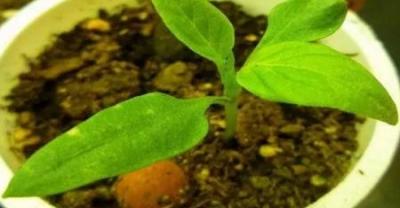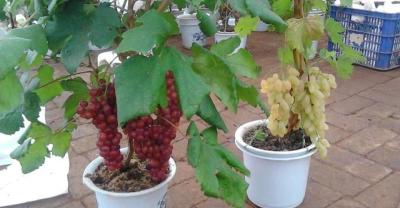Planting method of potted chili pepper on balcony
Potted vegetables on the balcony have never been less planted with chili peppers, which are not easy to grow insects, and the family also likes to eat them, but potted chili peppers bear too little fruit and are not enough to eat. Friends pot chili peppers on the balcony, chili peppers are not easy to grow insects, and the family also like to eat, that is, potted chili peppers bear too little, not enough to eat. The friend gave a move, the output can be much more than before, let's see what the method is!
Chili is not only delicious food, but also can be turned into a good-looking potted plant on the balcony. It is also interesting to plant potted vegetables on the balcony or balcony. It is a good idea to open up a small area on the balcony or balcony to grow potted vegetables, and the ornamental value of chili peppers is not low. In fact, as long as you can master the following pot chili planting steps, you can successfully grow a few pots of chili peppers for the whole family to eat, raising chili peppers is not difficult!

I. Climatic conditions of potted chili peppers
Pepper is a kind of temperature-loving plant, which is most suitable for growing in sunny places. Of course, it can also grow in shady places, but avoid planting chili peppers in places where there is no sunlight. It should be noted that high temperatures do great harm to chili peppers. Therefore, it is best to choose an area with tall plants when planting, so that the shade of the trees can cover the chili peppers during the high temperature period.
II. Soil conditions for growing chili peppers
Chili peppers are most suitable for growing in soils with pH values of 6.2 to 7.0. If your soil is highly acidic, add a little lime or plant ash to neutralize the pH value. If your soil is alkaline, adding pine needles or peat moss can neutralize the pH value.
Third, the steps of planting chili
Growing chili peppers outside the tropics and subtropics is best done indoors in the early days.
1. Soak the seeds in order to help the seeds germinate, soak the seeds in water and soften the covering film of the seeds. Soak the seeds in warm water for 24 hours, then remove them to dry.
2. After the seeds are completely dried (it usually takes 10 to 12 hours), the seeds can be sown. Put the soil with the right pH into a flowerpot and bury the seeds about half the depth.
3. Watering sprouting and watering every day to keep the soil moist, not too much. It takes days to weeks for seeds to germinate. The first pair of leaves that the seed sends out are called cotyledons. The next pair of leaves are called "true leaves". The emergence of true leaves means that pepper seedlings can be moved outdoors.
4. Plant the seedlings to an outdoor open space with a distance of 30 to 45 centimeters between the plants. insert some stents if necessary to help the plants stay upright. If you do not have the conditions for outdoor space, you can put the flowerpot in a sunny place, such as on the windowsill.
5. It takes at least a month or more for chili peppers to blossom and bear fruit, during which time they need to be taken care of carefully. Be sure to get rid of weeds regularly, because weeds will consume nutrients in the soil. Remember to apply compost and potash once a month. Usually, chili peppers take about two months to fully ripen and be harvested. But you can also let them stay a little longer before harvesting. The darker the fruit is, the more ripe it is.
6. Harvest the chili peppers from the top of the stem. Pulling hard on chili peppers can hurt fragile stems and roots. If frost is expected, pick all the fruits in advance, even if some are not ripe enough. Because Frosts Descent will destroy all the remaining fruit.
4. Key points of potted pepper planting on balcony
Timing: to choose the right time to plant chili peppers, the temperature is about 17-20 degrees Celsius can be planted, generally after the spring warm, pepper cultivation can choose different varieties, each variety is identified.
Environment: to grow chili peppers, you need to keep the environment slightly moist, avoid being too wet and keep plenty of sunshine.
Seed selection: many varieties can be selected before planting pepper pot, such as common Chaotian pepper, round pepper, colorful pepper and so on.
Soaking seeds: chili peppers do not need too much space to grow. About 30cm flowerpots can plant chili peppers. Chili seeds that are cultivated with seeds and soaked in water overnight are easy to sprout and seedlings grow quickly.
Disinfection: before sowing, you can soak the seeds in carbendazim solution for disinfection, then soak them in clean water for one night, or soak them gently for half an hour, and then sow seeds. The germination rate is particularly high and the germination is faster.
Container: the planting container should be at least 25 centimeters deep. The planting place should not be exposed to the sun at first, and the seedlings should be given enough scattered light.
Watering: after the seedlings grow strong, you can use 2 soup of Epsom salt, mixed with 4 liters of water, to spray pepper plants, so that you can harvest chili peppers more quickly.
Transplanting: avoid direct sunlight in the seedling stage, maintain sufficient scattered light, and so on when the seedlings grow to 4 true leaves, you can transplant, choose strong seedlings to cultivate, other seedlings can only give up.
Moisturizing: the root system of chili pepper is shallow, so keep in mind that the soil should not accumulate water, keep the basin soil moist or not, and don't let the soil be too dry.
Fertilization: if you want your chili to bear more fruit, you not only need to apply thin fertilizer frequently, but also need suitable fertilizer. In addition to daily topdressing, you can add the right amount of rotten cake fertilizer or animal manure under the pot soil at the beginning of transplanting. After the first result, you need to keep topdressing, once every half a month, in order to ensure a higher yield all the time.
- Prev

Notes on citrus planting management in June
This year into June since the continuous rain weather, making it more difficult to manage orchards, here is a summary of the overall, for everyone to do reference, pay attention to do a good job...
- Next

How do families grow potted grapes
How to grow potted grapes? potted grapes are glittering and translucent, exquisite and lovely, with green grape leaves and curved Saha branches. ...
Related
- Fuxing push coffee new agricultural production and marketing class: lack of small-scale processing plants
- Jujube rice field leisure farm deep ploughing Yilan for five years to create a space for organic food and play
- Nongyu Farm-A trial of organic papaya for brave women with advanced technology
- Four points for attention in the prevention and control of diseases and insect pests of edible fungi
- How to add nutrient solution to Edible Fungi
- Is there any good way to control edible fungus mites?
- Open Inoculation Technology of Edible Fungi
- Is there any clever way to use fertilizer for edible fungus in winter?
- What agents are used to kill the pathogens of edible fungi in the mushroom shed?
- Rapid drying of Edible Fungi

